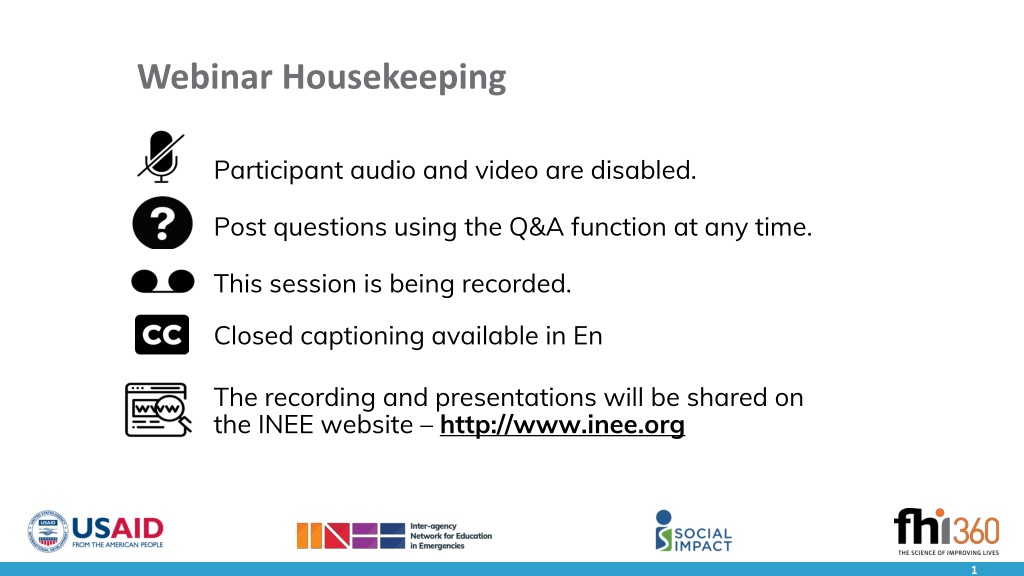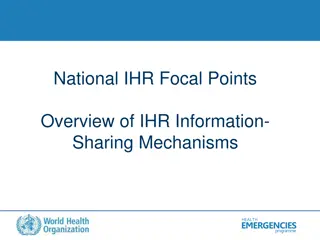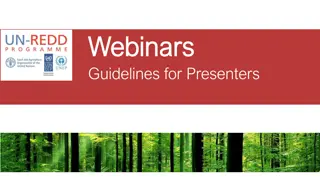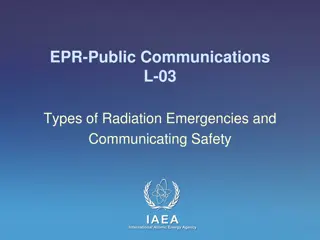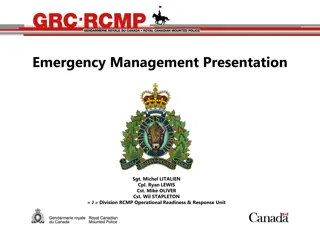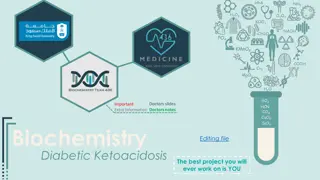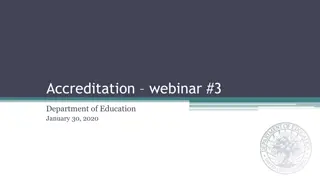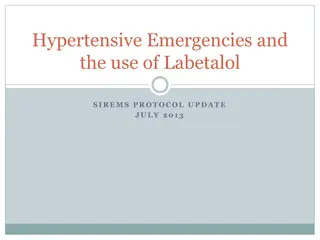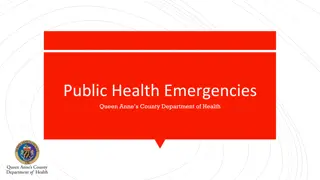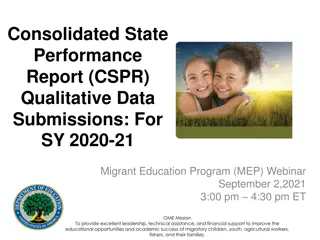Data Technologies and Education in Emergencies Webinar Summary
Explore the intersection of data technologies and education in emergency settings through a webinar featuring experts from FHI 360 and INEE. The session covers topics such as the role of technology, challenges, opportunities, and recommendations for data collection and communication. Discover how technology can enhance humanitarian efforts and improve real-time information sharing in crisis situations.
Download Presentation

Please find below an Image/Link to download the presentation.
The content on the website is provided AS IS for your information and personal use only. It may not be sold, licensed, or shared on other websites without obtaining consent from the author. Download presentation by click this link. If you encounter any issues during the download, it is possible that the publisher has removed the file from their server.
E N D
Presentation Transcript
Webinar Housekeeping Participant audio and video are disabled. Post questions using the Q&A function at any time. This session is being recorded. Closed captioning available in En The recording and presentations will be shared on the INEE website http://www.inee.org 1
June 2022 Data Technologies and Education in Emergencies Mark Buttweiler, M&E Specialist, FHI 360 Tanya Smith-Sreen, Program Officer, FHI 360 Rafael Contreras Gomez, Research Associate, FHI 360 Sonja Anderson, Evidence Coordinator, INEE
Roadmap Background Methods Findings Typology General Utility, Cost, Safety & Security Recommendations Call to contribute 3
Background Opportunity Challenges Goal Technological innovations aren t keeping up with the rapidly changing environment (Dahya, 2016) Create a typology of data technologies Technology s potential in the humanitarian sector Develop guiding principles for data collection, processing, and communication Rapidly changing nature of emergency setting can benefit from real-time information Existing research has looked at EdTech s potential to deliver content (Tauson & Stannard, 2018) Curate recommended practices for data collection, processing, and communication Lack of research on the use of data technologies within EiE constraints 5
Disclaimer This study does not focus on the use of technology for national education systems in crisis settings The focus of this paper is primarily on non-governmental EiE practitioners, both large and small, global, and local 6
Methods 7
Methods Desk Review Data Analysis Interviews 8
Methods Voto Mobile Twilio Desk Review Comm care ODK Data Analysis Interviews Apache Power BI Tableau 10
Methods Voto Mobile Twilio Desk Review Comm care ODK Data Analysis Interviews Apache Power BI Tableau 11
Methods Voto Mobile Twilio Desk Review Offline mobile surveys Comm care ODK Data Analysis Interviews Apache Power BI Tableau 12
Methods Voto Mobile Interactive Voice Response Twilio Desk Review Offline mobile surveys Comm care ODK Machine learning techniques Data Analysis Interviews Apache Dynamic Data Visualization Power BI Tableau 13
Methods Voto Mobile Interactive Voice Response Twilio Desk Review Offline mobile surveys Comm care ODK Machine learning techniques Data Analysis Interviews Apache Dynamic Data Visualization Power BI Tableau 14
Methods Voto Mobile Interactive Voice Response Data Collection Twilio Desk Review Offline mobile surveys Comm care ODK Machine learning techniques Data Analysis Interviews Apache Dynamic Data Visualization Power BI Tableau 15
Methods Voto Mobile Interactive Voice Response Data Collection Twilio Desk Review Offline mobile surveys Comm care ODK Data Processing Machine learning techniques Data Analysis Interviews Apache Data Communication Dynamic Data Visualization Power BI Tableau 16
Methods Voto Mobile Interactive Voice Response Data Collection Twilio Desk Review Offline mobile surveys Comm care ODK Data Processing Machine learning techniques Data Analysis Interviews Apache Data Communication Dynamic Data Visualization Power BI Tableau 17
Findings 20
Findings Data Collection Technologies Data quality and improved efficiency Strengthening information ecosystems Ease of adoption Richer qualitative data Exclusionary aspects and survey bias Low response rates and access issues General Utility Enhanced data security Enumerator and respondent safety risk Risk of data co-option Upfront vs long-term costs Tool dependent Software Hardware Human resources Safety & Security Costs 21
Recommendations Guiding Principles Do No Harm Follow GDPR and related standards New technology does not mean better technology Coordinate among stakeholders, adapting technologies using a systems-thinking approach. Develop innovations in collaboration with local organizations and end-users Introduce new technology as social and behavior change View technology as a long-term investment Nurture a culture of data feedback loops and DDDM 23
Recommendations Guiding Principles Do No Harm Follow GDPR and related standards New technology does not mean better technology Coordinate among stakeholders, adapting technologies using a systems-thinking approach. Develop innovations in collaboration with local organizations and end-users Introduce new technology as social and behavior change View technology as a long-term investment Nurture a culture of data feedback loops and DDDM 24
Recommendations Guiding Principles Do No Harm Follow GDPR and related standards New technology does not mean better technology Coordinate among stakeholders, adapting technologies using a systems-thinking approach. Develop innovations in collaboration with local organizations and end-users Introduce new technology as social and behavior change View technology as a long-term investment Nurture a culture of data feedback loops and DDDM 25
Recommendations Guiding Principles Do No Harm Follow GDPR and related standards New technology does not mean better technology Coordinate among stakeholders, adapting technologies using a systems-thinking approach. Develop innovations in collaboration with local organizations and end-users Introduce new technology as social and behavior change View technology as a long-term investment Nurture a culture of data feedback loops and DDDM 26
Recommendations Guiding Principles Poll Of these guiding principles, which three principles have been the most frequently used within your own practice? Of these guiding principles, which three principles have you either been aware of or have been the least frequently followed ? 27
Recommended Practices Data Collection Strategic Address direct and maintenance costs upfront Consider coordination and data sharing in advance Research the technological landscape Operational Duty of care is first and foremost Deploy multiple modes of collection Ensure clear survey design Tailor technological solutions to the culture in which it is being deployed Use familiar technologies when possible 28
Recommended Practices Data Processing Strategic Invest in more analytical support Obtain clarity on which data must be supplied to a client or government Build capacity in staff to leverage data Build expertise in multiple platforms Operational Use technology to ensure data is accurate and timely Automate data validation processes Develop processes to share analyses Triangulate data sources 29
Recommended Practices Data Communication Strategic Approach the use of new tools as change management Identify data champions Create a culture of data sharing Operational Provide data in a timely fashion Follow data visualization best practices and simplify reporting Use row-level security to limit access to data Ensure systems are maintained 30
Crowd-sourcing Insights Problem Solution -Nuances on advantages, disadvantages and recommended practices dependent on technology -Develop a dashboard with insights for specific technologies -Incorporate a feedback mechanism to crowd- source insights -Curating a list of tools is costly and will change rapidly with advances in technology -Provide a means to add new tools as they are created -Cost and ease of use data hard to compare 32
Thank you! Please reach out with any questions or comments! Mark Buttweiler mbuttweiler@fhi360.org Tanya Smith-Sreen tsmith-sreen@fhi360.org Rafael Contreras Gomez rcontrerasgomez@fhi360.org Dashboard: https://tinyurl.com/ajm4p9rj 34
